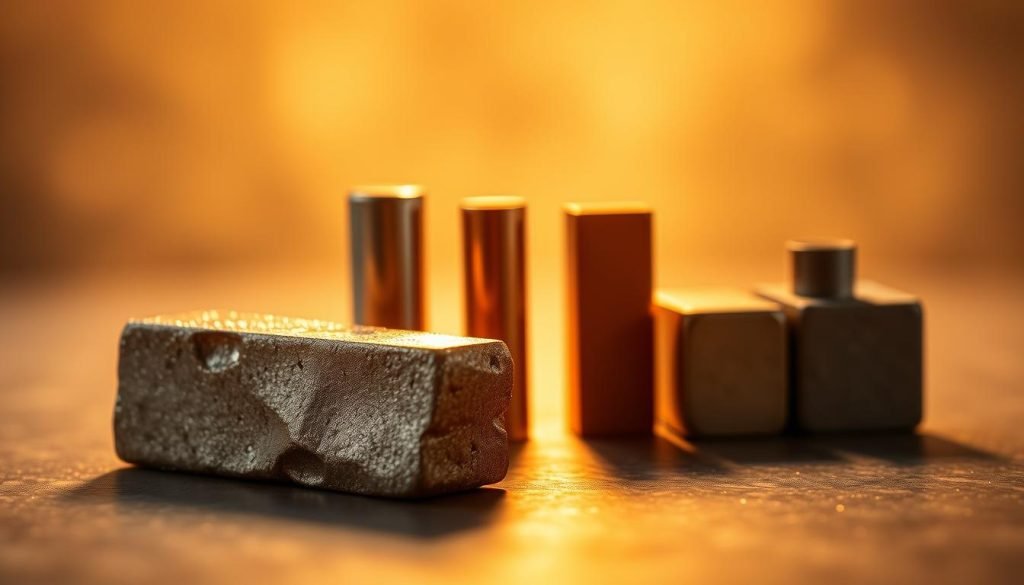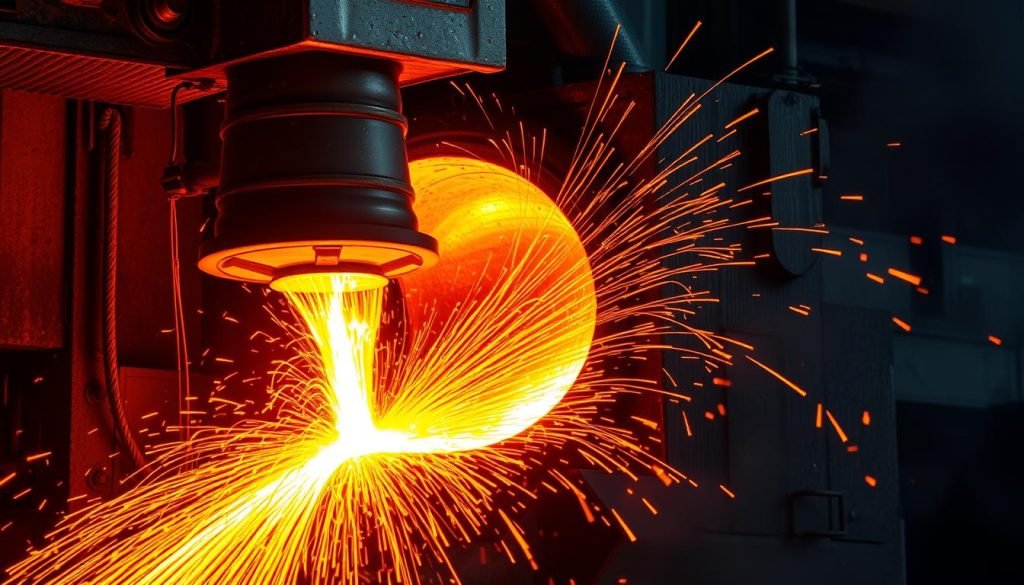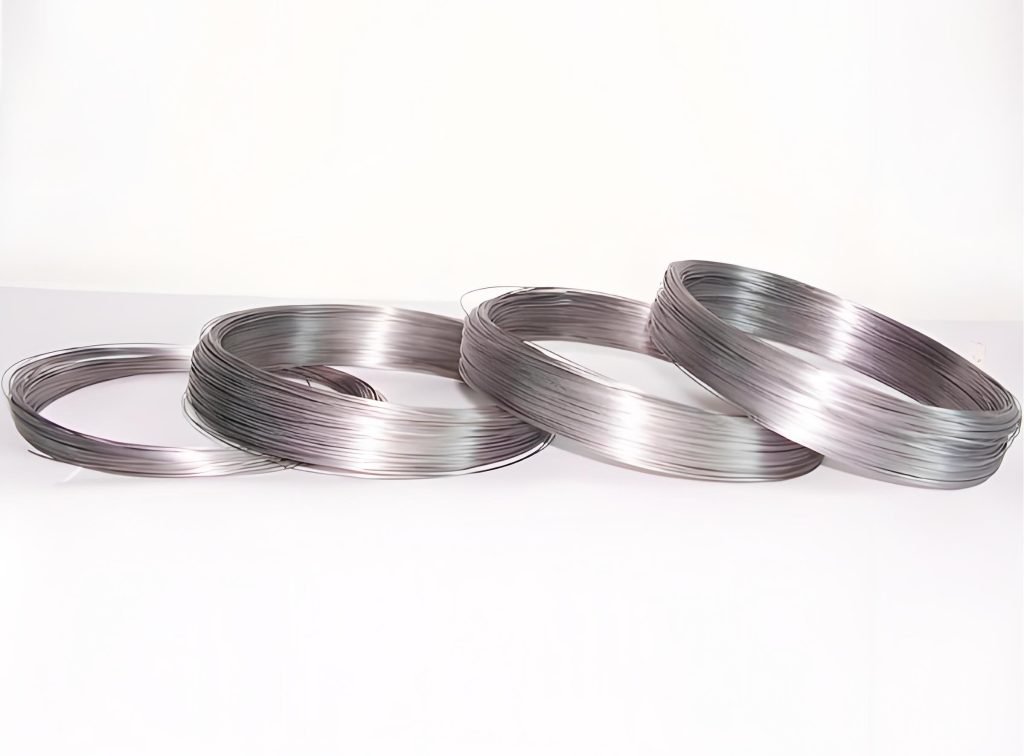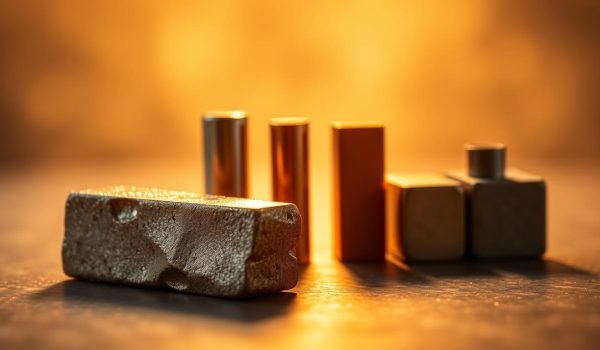You might be surprised to know that tungsten has the highest melting point of all metals, at a staggering 3,422°C (6,192°F). This remarkable property makes it an invaluable element for applications that require extreme heat resistance.
As a refractory metal, tungsten maintains its structural integrity at temperatures where other metals melt. Its exceptional thermal properties are due to its
unique atomic structure and bonding characteristics.
Understanding tungsten’s high melting point is crucial for engineers and manufacturers working with high-temperature processes. This knowledge enables the development of components that can withstand extreme thermal conditions, making tungsten a vital material in various industries.

Understanding Tungsten: The Basics
To understand tungsten’s significance, it’s essential to explore its fundamental characteristics and history. You might be wondering what makes tungsten so unique and how it earned its place in the periodic table.
What is Tungsten?
Tungsten is a rare transition metal with the chemical symbol W and atomic number 74. It’s characterized by its extraordinary density (19.3 g/cm³) and remarkable heat resistance properties. As an element, tungsten does not occur freely in nature but is found in minerals such as wolframite (iron/manganese tungstate) and scheelite (calcium tungstate).
Historical Discovery and Naming
Tungsten was first isolated in 1783 by Spanish chemists Juan José and Fausto Elhuyar through charcoal reduction of tungsten oxide derived from wolframite. The name “tungsten” comes from Swedish, meaning “heavy stone,” while “wolfram” derives from the mineral wolframite. This dual naming convention reflects the element’s complex history and different naming traditions in various countries.
The Remarkable Tungsten Melting Point
When it comes to withstanding extreme temperatures, tungsten’s melting point is unparalleled. This characteristic makes tungsten a crucial material in various high-temperature applications.
Exact Melting Point Value
Tungsten has a melting point of 3,410°C (6,152°F), which is the highest among all elements. This value signifies tungsten’s exceptional ability to remain solid at temperatures that melt other metals.
Comparison with Other Elements
Compared to other metals, tungsten’s melting point is significantly higher. For instance, iron melts at 1,538°C (2,800°F), and titanium at 1,668°C (3,034°F). Even other refractory metals like molybdenum have a lower melting point, at 2,623°C (4,753°F). This comparison underscores tungsten’s unique properties.
Significance in Material Science
The significance of tungsten’s melting point extends beyond its numerical value. It represents a critical threshold in material science, enabling applications that are impossible with materials having lower melting points. Understanding this property helps engineers select appropriate materials for extreme environments.
Atomic Structure: The Science Behind Tungsten’s Heat Resistance
You might wonder what makes tungsten so resistant to heat; the answer lies in its unique atomic configuration. Tungsten’s exceptional properties stem from its atomic structure, which is characterized by a specific electron configuration and crystal arrangement.
Electron Configuration and Bonding
Tungsten has an electron configuration of [Xe]4f5d6s, which allows for multiple metallic bonding states. This creates a robust and stable lattice structure due to the presence of d-electrons. The d-orbital electrons participate in complex bonding arrangements, distributing electron density throughout the metal and strengthening interatomic forces.
Crystal Structure Properties
Tungsten atoms are arranged in a body-centered cubic (BCC) crystal structure, contributing to its density and strength. This arrangement results in high cohesive energy, requiring significant energy to break the bonds between tungsten atoms. The BCC structure provides optimal packing of atoms, creating a highly coordinated lattice that resists thermal disruption even at extreme temperatures.
Why Tungsten Has a High Melting Point
You might wonder why tungsten has such a high melting point; it’s due to its robust atomic bonds. Tungsten’s melting point is one of the highest among all elements, and this property makes it invaluable in various industrial applications.

Strong Metallic Bonding
Tungsten’s high melting point is largely due to the strong metallic bonding between its atoms. In this bonding, delocalized electrons create powerful electrostatic forces that resist thermal disruption, making it difficult for the atoms to vibrate freely and break away from their lattice positions.
High Atomic Mass and Density
The high atomic mass of tungsten (183.84 u) and its dense atomic structure play a crucial role in its thermal stability. Heavier atoms require more energy to increase their vibrational motion sufficiently to break from their lattice positions. Additionally, tungsten’s impressive density (19.3 g/cm³) results in closely packed atoms, creating bonds that require an extraordinary amount of thermal energy to overcome.
Body-Centered Cubic Structure
Tungsten’s body-centered cubic (BCC) crystal structure provides optimal coordination between atoms, with each atom surrounded by eight neighbors in a configuration that maximizes bonding strength and stability. This highly coordinated lattice contributes significantly to tungsten’s high melting point.
These factors combined create a material with exceptional cohesive energy, meaning the amount of energy required to separate tungsten atoms from their solid state is significantly higher than for other metals, directly translating to its record-setting melting point.
Physical Properties of Tungsten Beyond Melting Point
Beyond its high melting point, tungsten boasts several physical properties that contribute to its widespread use. You will find that these properties make tungsten an invaluable material in various industrial applications.
Density and Hardness
Tungsten has a density of 19.3 grams/cm³ at 20°C (68°F), making it one of the densest elements. Its exceptional density, comparable to gold, combined with its high temperature resistance, makes it ideal for applications requiring both weight and heat resistance. The metal exhibits remarkable hardness, with a Mohs hardness of 7.5, and compressive strength, although it tends to be brittle at room temperature unless processed through mechanical working at elevated temperatures.
Thermal and Electrical Conductivity
Tungsten’s thermal expansion coefficient is exceptionally low (4.43 × 10−6 per °C), providing dimensional stability across temperature ranges. The combination of good thermal conductivity with exceptional heat resistance makes tungsten uniquely suited for applications that must simultaneously transfer heat and withstand extreme temperatures without deformation. Additionally, tungsten has good electrical conductivity properties, further expanding its utility in various industrial contexts.
Tungsten Melting Point Comparison with Other Metals
Tungsten’s exceptionally high melting point sets it apart from other metals, making it a crucial material for high-temperature applications. You might wonder how it stacks up against other metals in terms of heat resistance.
Comparison with Common Metals
Tungsten’s melting point of 3,422°C far exceeds that of common metals like iron (1,538°C), copper (1,085°C), and aluminum (660°C). This significant difference makes tungsten ideal for environments where these metals would melt or deform. For instance, tungsten is used in rocket nozzles and high-temperature furnace components where extreme heat resistance is necessary.
Comparison with Other Refractory Metals
Even among other refractory metals known for their high melting points, tungsten stands out. Its melting point surpasses that of rhenium (3,186°C), molybdenum (2,623°C), tantalum (3,017°C), and niobium (2,477°C). This superiority makes tungsten the material of choice for the most demanding high-temperature applications, such as heating elements and advanced aerospace components.
Tungsten Alloys and Their Melting Points
Tungsten alloys are engineered to combine the exceptional heat resistance of pure tungsten with other desirable properties. These alloys are formed by combining tungsten with various metals, including molybdenum, rhenium, and nickel, to create materials suitable for a wide range of specialized applications.
Common Tungsten Alloys
You’ll find that common tungsten alloys include tungsten-rhenium, used in thermocouples and heating elements, and tungsten-copper, used in electrical contacts. Other notable alloys are tungsten-nickel-copper and tungsten-nickel-iron, which are utilized for radiation shielding and counterweights. These alloys demonstrate the versatility of tungsten when combined with other metals.
How Alloying Affects Melting Point
While alloying generally reduces the melting point compared to pure tungsten, many tungsten alloys still maintain extraordinarily high melting points. For instance, tungsten-molybdenum alloys melt around 3,100°C (5,612°F). Tungsten carbide (WC), though technically a compound, is noteworthy for its exceptional hardness and use in cutting tools, despite having a lower melting point (2,870°C) than pure tungsten. The ability to tailor these alloys allows engineers to balance high melting points with other desirable properties.
How to Melt Tungsten: Challenges and Techniques
Achieving the melting of tungsten is a feat that demands high temperatures and precise methods. Melting tungsten requires extremely high temperatures, exceeding its melting point of 3,422°C (6,192°F).
Industrial Melting Methods
Industrial melting of tungsten typically employs electric arc furnaces, electron beam melting, or plasma arc melting. These processes are capable of generating the extreme temperatures necessary to liquefy this refractory metal.
Equipment and Safety Considerations
The equipment used must withstand not only the target melting temperature but significantly higher temperatures to ensure proper heat transfer and complete melting. Safety considerations are paramount when working with such extreme temperatures, necessitating robust protective measures and comprehensive emergency protocols.
When melting tungsten alloys, the process becomes even more complex due to the varying melting points of the constituent metals. Understanding these challenges is crucial for successful industrial applications.
Applications in Lighting Industry
Tungsten’s exceptional characteristics make it ideal for various lighting applications. You will find that its high melting point and ability to be drawn into fine wire make it particularly useful.

Incandescent Lamp Filaments
Tungsten filaments revolutionized electric lighting in the early 20th century. Pure tungsten can be made ductile and drawn into very fine wire, creating filaments that provide the optimal balance of light output and longevity in traditional incandescent bulbs. The high melting point of tungsten allows these filaments to reach temperatures of around 2,500°C without melting.
Modern Lighting Technologies
While LED technology has reduced the use of tungsten filaments in general lighting, they remain important in specialty lighting, including halogen lamps. The automotive industry continues to utilize tungsten filaments in vehicle lighting applications, particularly for turn signals and some interior lighting, where the instantaneous illumination and warm light characteristics are advantageous.
Tungsten in Aerospace and Defense
Tungsten’s exceptional properties make it a critical material in the aerospace and defense industries. Its high melting point and density are particularly valuable in applications where components must withstand extreme conditions.
Heat Shields and Rocket Nozzles
Tungsten is used in the fabrication of rocket-engine nozzle throats and leading-edge reentry surfaces due to its ability to withstand high temperatures. You’ll find tungsten and its alloys used in rocket engine nozzles and throat liners, where temperatures can exceed 3,000°C during operation. Spacecraft heat shields also benefit from tungsten’s heat resistance, maintaining their integrity during atmospheric reentry.
Ballast and Counterweights
The remarkable density of tungsten (19.3 g/cm³) makes it invaluable for ballast and counterweights in aircraft control surfaces and stabilization systems. Military applications also utilize tungsten alloy kinetic energy penetrators and fragmentation materials, leveraging its density and strength for superior performance. These applications demonstrate tungsten’s versatility in meeting the demanding requirements of the aerospace and defense industries.
Applications in Electronics and Electrical Industry
Tungsten plays a crucial role in the electronics and electrical industries due to its unique properties. Its high melting point and good electrical conductivity make it an ideal material for various applications.
Electrical Contacts and Electrodes
Tungsten is widely used in electrical contacts and electrodes for high-current applications. Its resistance to arc erosion and material transfer makes it superior to other metals. This property is crucial for maintaining the integrity of electrical connections.
Integrated Circuits and Semiconductors
In semiconductor manufacturing, tungsten serves as an essential material for interconnects and gate electrodes in integrated circuits. Its ability to withstand high temperatures provides the thermal stability needed for high-temperature processing steps, ensuring the reliability of semiconductor devices.
Tungsten in Medical Applications
You might be surprised at how often tungsten is used in medical devices and equipment. The medical industry is increasingly turning to tungsten for specialized applications where its unique properties offer advantages over traditional materials.
Radiation Shielding
Tungsten’s high density makes it an excellent material for radiation shielding in medical applications, often replacing lead due to environmental concerns. It’s used in medical imaging equipment, radiation therapy devices, and radiopharmaceutical containers.
Surgical Instruments and Implants
Tungsten alloys are used in surgical instruments that require weight and balance, providing the heft and precision feel that surgeons prefer. Some medical implants utilize tungsten due to its biocompatibility and radiopacity, allowing for clear visualization under X-ray imaging.
Industrial Manufacturing Applications
Tungsten’s exceptional properties make it a crucial material in various industrial manufacturing applications. You can find tungsten used extensively in processes that require high heat resistance and wear tolerance.
High-Temperature Furnaces and Crucibles
Tungsten is used in high-temperature furnaces and crucibles due to its extraordinary melting point, allowing it to contain molten metals and other materials that would damage less heat-resistant containers. This property makes tungsten ideal for metal processing and crystal growth applications.
Cutting Tools and Dies
Tungsten carbide has revolutionized the cutting tool industry by providing exceptional hardness and wear resistance for drills, end mills, and cutting inserts. Dies and forming tools for metalworking operations also benefit from tungsten carbide’s combination of hardness and compressive strength.
Tungsten Carbide: The Hardest Tungsten Compound
Tungsten carbide is renowned for its exceptional hardness, making it a crucial material in various industrial applications. You can find this compound used in a wide range of products, from cutting tools to wear parts.
Properties and Manufacturing
Tungsten carbide is produced by reacting tungsten metal powder with carbon at high temperatures, typically between 1,400-1,600°C. This process creates a ceramic-like material with metallic properties, offering exceptional wear resistance and durability. The resulting compound has a rating of 9.5 on the Mohs scale, making it one of the hardest man-made materials available.
Industrial Applications
Tungsten carbide is used in various industrial applications, including cutting tools, mining bits, wear parts, and high-pressure components. Its unique combination of extreme hardness, compressive strength, and good thermal conductivity makes it an ideal material for these applications. You can also find tungsten carbide used in specialized metal parts, such as nozzles for abrasive environments and high-performance bearings.
Environmental and Health Considerations
As you explore the uses of tungsten, it’s also important to consider its environmental and health impacts. The extraction and processing of tungsten from ores like wolframite and scheelite can have significant environmental effects.
Mining and Processing Impact
The production of tungsten begins with mining ores, a process that requires careful environmental management to minimize land disturbance, water usage, and potential contamination. You should be aware that tungsten mining can create environmental challenges, including habitat disruption and water usage concerns, if not properly managed.
Safety Measures in Tungsten Industries
Worker safety in tungsten industries is crucial, particularly in controlling exposure to tungsten dust, which can cause respiratory issues with prolonged exposure. Implementing safety measures, such as dust control systems and personal protective equipment, is essential for minimizing health risks associated with tungsten production and processing.
Conclusion: The Future of Tungsten in High-Temperature Applications
As we explore the vast applications of tungsten, it’s clear that its high melting point makes it an indispensable material. You can expect to see tungsten increasingly utilized in advanced medical devices where precision CNC machining creates components that benefit from its unique combination of density, strength, and biocompatibility.
Aerospace and defense applications will continue to rely on tungsten’s unmatched melting point for components that must withstand extreme thermal environments. The growing demand for high-performance tools and wear-resistant parts ensures tungsten carbide will remain essential in manufacturing industries.
As industries push the boundaries of what’s possible in extreme environments, tungsten’s position as the highest melting point metal ensures it will remain irreplaceable. With ongoing research and development, new applications will continue to emerge, leveraging tungsten’s exceptional properties for metal parts that require high melting points.
Tungsten’s continued importance in high-temperature applications is a testament to its versatility and the value it brings to various industries, from medical devices to aerospace components.




